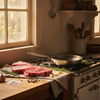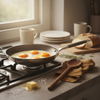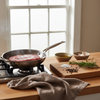Steak On Stainless Steel Pan: The Ultimate Guide
Key Takeaways
- Cooking steak on a stainless steel pan can achieve restaurant-quality results at home.
- Stainless steel pans provide precise heat control that enhances the cooking process.
- Using stainless steel eliminates the risk of chemical leaching found in some other pans.
- Stainless steel pans allow you to create a perfect crust on your steak without sacrificing flavor or health.
- Unlike cast iron and nonstick, stainless steel offers a unique combination of benefits for cooking steak.
Table of Contents
- Why Cook Steak in a Stainless Steel Pan?
- Selecting Your Steak: Cuts, Thickness, and Prep Essentials
- Step-by-Step: Cooking the Perfect Steak on Stainless Steel
- Understanding Doneness: The Precise Temperature Guide
- Stainless Steel vs. Cast Iron vs. Nonstick: Sear Showdown
- Tools for Success: Choosing the Best Stainless Steel Pans and Pro-Grade Spatulas
- Perfect Steak Seasoning for Stainless Steel Searing
- Troubleshooting Steak Searing in Stainless Steel
- Storing, Reheating, and Using Leftover Steak
Steak on Stainless Steel Pan, Upgrade Your Sear, Protect Your Health, Unleash Your Culinary Creativity
Cooking steak on stainless steel pan delivers restaurant-quality results at home, if you know the technique. While cast iron gets the glory and nonstick gets the convenience, stainless steel offers something neither can: precise heat control, zero chemical leaching, and the ability to create a perfect crust without compromising your health or flavor.
The secret lies in understanding heat dynamics and having the right tools. With proper preheating and DI ORO's award-winning seamless spatulas (heat-resistant to 600°F and forever-chemical-free), you'll achieve that coveted golden-brown crust while keeping your food, and conscience, clean.
For even more control when flipping or serving, consider using 12-inch stainless steel kitchen tongs designed for high-heat cooking. These tools help you handle steak confidently and safely, ensuring a perfect sear every time.
Why Cook Steak in a Stainless Steel Pan?
Stainless steel excels at the Maillard reaction, the chemical process that creates steak's signature crust and complex flavors. Unlike nonstick surfaces that struggle above 400°F, stainless steel thrives at the 450-500°F range needed for proper searing. The material's thermal conductivity ensures even browning, while its non-reactive surface won't interfere with acidic marinades or wine-based pan sauces.
Health-conscious home chefs choose stainless steel for what it doesn't contain: PFAS, PFOA, or other forever chemicals that can leach into food at high temperatures. When paired with DI ORO's LFGB-certified spatulas, tested by America's Test Kitchen and rated as the most versatile on the market, you're cooking with tools that prioritize both performance and safety.
The creative possibilities expand with stainless steel's durability. You can deglaze directly in the pan, build complex sauces, and transition seamlessly from stovetop to oven. This versatility transforms a simple steak on stainless steel pan into the foundation for memorable culinary moments.
Professional kitchens rely on stainless steel for good reason: consistent results, easy maintenance, and the confidence that comes from using tools designed to perform under pressure. Your home kitchen deserves the same standard.
Selecting Your Steak: Cuts, Thickness, and Prep Essentials

Cut selection determines your success before the pan even heats. Ribeye's marbling provides built-in insurance against overcooking, while New York strip offers consistent thickness for even searing. Filet mignon requires gentle handling but rewards with unmatched tenderness. Top sirloin delivers excellent value with proper technique.
| Cut | Ideal Thickness | Fat Content | Best For |
|---|---|---|---|
| Ribeye | 1-1.5 inches | High marbling | Forgiving, rich flavor |
| NY Strip | 1-1.25 inches | Moderate | Consistent results |
| Filet Mignon | 1.5-2 inches | Low | Special occasions |
| Top Sirloin | 1 inch | Lean | Budget-friendly |
Thickness matters more than cut quality. Steaks under 1 inch cook too quickly to develop proper crust, while those over 1.5 inches may require oven finishing. The sweet spot, 1 to 1.25 inches, allows sufficient time for browning while maintaining control over doneness.
Preparation starts 30-45 minutes before cooking. Room temperature steak sears evenly; cold steak creates hot spots. Pat surfaces completely dry with paper towels, moisture is the enemy of browning. Season generously with kosher salt and fresh cracked pepper, either immediately before cooking or 40+ minutes prior (never in the 10-30 minute window, which draws out moisture without time for reabsorption).
Use DI ORO's seamless spatulas for all prep work, their bacteria-resistant surface and easy-clean design eliminate cross-contamination concerns while providing the precision needed for professional-quality results.
For more tips on choosing the right cut and prepping your steak, check out this guide on how to cook steak on stainless steel pan.
Step-by-Step: Cooking the Perfect Steak on Stainless Steel
Preheating for Precision
Heat your stainless steel pan over medium heat for 3-4 minutes. Test readiness with a water droplet, it should dance and evaporate within 2-3 seconds, not sit and bubble. Insufficient preheating guarantees sticking; overheating creates hot spots that burn before browning.
Adding the Right Oil
Choose high smoke-point oils: avocado (520°F), refined sunflower (450°F), or canola (400°F). Add 1 tablespoon to a 10-12 inch pan, swirling to coat evenly. The oil should shimmer but not smoke, that's your cue to add the steak.
Never use butter for the initial sear (it burns at 350°F). Save compound butters for the final basting stage when temperatures drop.
Steak to Pan, The Sear Sequence
Place the steak gently away from you to avoid oil splatter. You'll hear an immediate sizzle, that's the Maillard reaction creating your crust. Don't move the steak for 3-4 minutes; it will naturally release when properly seared.
Use your Chef 3-Piece Spatula Turner Set to check for doneness, slide it gently under the edge. If it resists, give it another minute. The steak will tell you when it's ready.
The Flip (and Why It Matters)
Flip once for traditional searing, or every 90 seconds for more even cooking, both methods work brilliantly on stainless steel. The key is using tools that won't scratch your pan or leach chemicals into your food.
DI ORO's seamless spatulas excel here: heat-resistant to 600°F with a reinforced steel core that won't bend under pressure. One confident flip, and you're golden.
Basting for Aromatics & Gloss
In the final 90 seconds, add 2 tablespoons butter, smashed garlic cloves, and fresh thyme. Tilt the pan and baste continuously, spooning the foaming butter over the steak every 15 seconds.
This technique, borrowed from French bistros, adds richness and creates that restaurant-quality gloss. Your DI ORO spatula's flexible edge makes basting effortless and safe.
For a detailed walkthrough, see this article on steak in stainless steel pan.
Understanding Doneness: The Precise Temperature Guide
Perfect steak on stainless steel pan requires precision, not guesswork. Remove your steak 5°F below target temperature, carryover cooking during the rest period will hit your mark exactly.
| Doneness | Target Temp | Remove At | Texture | Cook Time (1-inch) |
|---|---|---|---|---|
| Rare | 125°F | 120°F | Cool red center | 6-7 minutes total |
| Medium-rare | 135°F | 130°F | Warm red center | 7-8 minutes total |
| Medium | 145°F | 140°F | Pink throughout | 9-10 minutes total |
| Medium-well | 150°F | 145°F | Slight pink center | 10-12 minutes total |
Use a quick-read thermometer inserted horizontally into the thickest part. The beauty of stainless steel is its even heat distribution, no hot spots to throw off your timing.
For more on mastering doneness and troubleshooting, you might also enjoy this guide on cooking steak in stainless steel pan.
Stainless Steel vs. Cast Iron vs. Nonstick: Sear Showdown

Each pan material excels in different scenarios, but for health-conscious home chefs who demand versatility, stainless steel leads the pack. Here's how they stack up for steak searing:
| Feature | Stainless Steel | Cast Iron | Nonstick |
|---|---|---|---|
| Crust Formation | Excellent browning | Superior heat retention | Poor browning |
| Health Safety | Zero chemical leaching | Safe when seasoned | PFOA/PFAS concerns |
| Heat Distribution | Even, responsive | Retains heat longer | Even but limited temp |
| Cleanup | Dishwasher safe | Hand wash only | Easy but fragile |
| Oven Safe | Up to 500°F+ | Up to 500°F+ | Usually 350°F max |
| Longevity | Decades with care | Generational | 2-3 years typical |
Stainless steel wins for everyday versatility, it heats quickly, responds to temperature changes, and delivers precise control for delicate sauces and aromatics. Cast iron excels for high-heat searing but demands seasoning maintenance. Nonstick offers convenience but can't handle the temperatures needed for proper caramelization.
For home chefs who dream big and cook with heart, stainless steel provides the perfect canvas, no chemical concerns, restaurant-quality results, and the versatility to go from stovetop searing to oven finishing without missing a beat.
If you're interested in the science behind pan-searing, explore this comprehensive resource from Serious Eats: the complete guide to pan-seared steaks.
Tools for Success: Choosing the Best Stainless Steel Pans and Pro-Grade Spatulas
Your steak deserves better than melted plastic and chemical leaching. The right pan paired with forever-chemical-free tools transforms good intentions into memorable meals.
Essential Pan Features: Look for 10-12 inch diameter with tri-ply construction, aluminum core sandwiched between stainless steel layers for even heat distribution. Heavy-gauge bottoms prevent hot spots that create uneven searing. Oven-safe handles rated to 500°F+ allow seamless stovetop-to-oven transitions for thick cuts.
But here's where most home chefs stumble: using tools that can't handle the heat. DI ORO's 4-Piece Seamless Spatula Set are engineered with pro-grade silicone that won't melt, warp, or leach chemicals at temperatures up to 600°F. The reinforced steel core provides the strength needed for confident flipping without bending under pressure.
America's Test Kitchen didn't crown DI ORO the Best Silicone Spatula by accident, our seamless design eliminates bacteria-harboring crevices while delivering the precision control that separates amateur from pro. When Food Network calls it the best spoonula on the market, you know you're holding kitchen gold.
For additional versatility, try the 2-piece kitchen tongs set (9-inch and 12-inch) for effortless flipping and serving of steaks and sides.
Perfect Steak Seasoning for Stainless Steel Searing
Great steak starts with great seasoning, and timing matters more than most realize. Kosher salt and freshly cracked black pepper remain the gold standard: ¼ teaspoon of each per inch of steak thickness, applied either immediately before cooking or 40+ minutes prior for deeper penetration.
Avoid the 10-30 minute window, salt draws moisture initially, creating a barrier that prevents proper browning. Either season and cook immediately, or give salt time to dissolve and reabsorb for enhanced flavor.
For elevated results, try this DI ORO signature blend: 2 tablespoons brown sugar, 1 tablespoon smoked paprika, 2 teaspoons garlic powder, 1 teaspoon each of kosher salt, black pepper, and dried thyme. The sugar caramelizes beautifully in stainless steel, creating complex depth without overpowering the beef. Finish with compound butter made from softened butter, minced garlic, fresh herbs, and a pinch of flaky sea salt, let it melt over the resting steak for restaurant-worthy presentation.
Troubleshooting Steak Searing in Stainless Steel

Preventing Sticking Issues
Sticking happens when proteins bond with the pan surface before proper searing occurs. The solution: adequate preheating (2-4 minutes on medium), proper oil application (high smoke-point oils only), and patience. When steak is ready to flip, it releases naturally, forcing it tears the crust and defeats the purpose.
Achieving Proper Browning
Pale, gray steak signals insufficient heat or excess moisture. Pat steaks completely dry, ensure your pan reaches proper temperature (water droplets should dance and evaporate quickly), and avoid overcrowding. One steak per 10-inch pan allows proper heat circulation and prevents steam buildup that inhibits browning.
Fixing Uneven Cooking
Thick steaks often develop perfect crusts while remaining raw inside. After initial searing, transfer the entire pan to a 400°F oven for 2-4 minutes. Use a reliable instant-read thermometer and remember, internal temperature continues rising 5°F during rest, so pull steaks slightly early.
Cleaning After Steak Night
Let the pan cool slightly, then deglaze with warm water to loosen fond (those beautiful brown bits). For stubborn residue, create a paste with baking soda and water, let sit 10 minutes, then scrub gently with your DI ORO spatula, its seamless silicone won't scratch the surface while effectively removing stuck-on bits.
For more on the health and safety of stainless steel cookware, see this article from the National Institutes of Health: stainless steel cookware and food safety.
Storing, Reheating, and Using Leftover Steak
Properly stored steak maintains quality for 3-4 days refrigerated. Cool completely before wrapping tightly in plastic or storing in airtight containers, this prevents moisture loss and bacterial growth.
Reheating requires finesse to avoid overcooking. The gentle method: slice against the grain, then warm in a stainless steel pan over low heat with a splash of beef broth, flipping carefully with your DI ORO spatula or tongs. This keeps the steak juicy and prevents it from drying out. For a quick steak sandwich or salad, let the steak come to room temperature and slice thinly for best texture.
For more tips on kitchen tools, see our article on stainless steel tongs.
Frequently Asked Questions
What are the advantages of cooking steak on a stainless steel pan compared to cast iron or nonstick pans?
Stainless steel pans offer precise heat control and excel at reaching the high temperatures needed for a perfect sear without chemical leaching. Unlike nonstick pans, they handle heat up to 500°F without degradation, and unlike cast iron, they provide a non-reactive surface that won’t alter flavors or react with acidic ingredients.
How do I properly preheat and sear a steak on a stainless steel pan to achieve the perfect crust?
Preheat your stainless steel pan until a water droplet dances and evaporates quickly, indicating the right temperature. Use a high smoke-point oil, then place the steak in the pan without moving it to develop a golden-brown crust before flipping to finish cooking to your desired doneness.
Which steak cuts are best suited for cooking on a stainless steel pan and why?
Cuts like ribeye, strip steak, and filet mignon work best because their thickness and marbling benefit from stainless steel’s even heat distribution, allowing for a flavorful crust while maintaining juicy tenderness inside.
What tools and techniques can help ensure safe and effective handling of steak while cooking on stainless steel?
Using 12-inch stainless steel kitchen tongs provides a secure grip for flipping and moving steak without piercing the meat, preserving juices. Pair these with DI ORO’s heat-resistant, chemical-free spatulas to scrape and serve confidently while protecting your pan and food.




